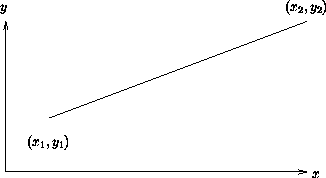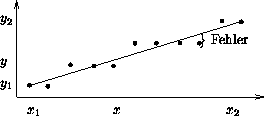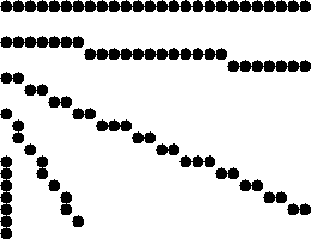| Problem: | Gegeben sind Anfangs- und Endkoordinaten einer Linie. Berechne die ``anzuschaltenden'' Pixel. |

1. Möglichkeit: Bestimme Geradengleichung
y = s · x + c
Es gilt:


Daraus ergibt sich folgender Algorithmus unter Verwendung der Klasse java.awt.Point
mit den beiden Integer-Koordinaten x und y:
void plot_line(Point P, Point q)
{
double s, c;
Point p = new Point(P);
s = (double) (q.y-p.y) / (double) (q.x-p.x);
c = (double) (p.y*q.x - q.y*p.x) / (double) (q.x - p.x );
while (p.x <= q.x) {
p.y = (int)(s*p.x + c + 0.5);
set_pixel(p);
p.x++;
}
}
Verfahren hat 2 Nachteile:
| Lösung: | Bresenham-Algorithmus |
| Idee: | Berechne den nächsten y -Wert aus dem vorherigen. Merke den momentanen Fehler. |
| Zunächst: | Gerade verläuft im 1. Oktanten (d.h. Steigung < 1) |
void bresenham_linie_1(Point P, Point q)
{
int dx, dy;
double s, e;
Point p = new Point(P);
dx = q.x - p.x;
dy = q.y - p.y;
e = 0.0;
s = (double) dy / (double) dx;
while (p.x <= q.x) {
set_pixel(p);
p.x++;
e += s;
if (e > 0.5) { p.y++; e-- ; }
}
}
Eliminiere Gleitkommazahlen durch Multiplikation von s mit 2*dx:
void bresenham_linie_2(Point P, Point q)
{
int dx, dy, error, delta;
Point p = new Point(P);
dx = q.x - p.x;
dy = q.y - p.y;
error = 0;
delta = 2*dy;
while (p.x <= q.x) {
set_pixel(p);
p.x++;
error += delta;
if (error > dx) { p.y++; error -= 2*dx; }
}
}
Vergleiche error mit 0 und verwende Abkürzung schwelle für -2*dx
void bresenham_linie_3(Point P, Point q)
{
int dx, dy, error, delta, schwelle;
Point p = new Point(P);
dx = q.x - p.x;
dy = q.y - p.y;
error = -dx;
delta = 2*dy;
schwelle = -2*dx;
while (p.x <= q.x) {
set_pixel(p);
p.x++;
error += delta;
if (error > 0) { p.y++; error += schwelle; }
}
}
Geraden in den anderen 7 Oktanten müssen durch Spiegelung und/oder Vertauschen von x und y auf den 1. Oktanten zurückgeführt werden.

Vom Bresenham-Algorithmus erzeugte Linien
/****************************************************************************************/
/* */
/* Bresenham-Algorithmus zum Zeichnen einer Linie */
/* */
/****************************************************************************************/
private void bresenham_linie( // zeichnet mit Bresenham-Algorithmus
Point P, Point q) // eine Linie von Punkt P nach Punkt q
{
Point p = new Point(P);
int error, delta, schwelle, dx, dy, inc_x, inc_y;
dx = q.x - p.x;
dy = q.y - p.y;
if (dx>0) inc_x= 1; else inc_x=-1;
if (dy>0) inc_y= 1; else inc_y=-1;
if (Math.abs(dy) < Math.abs(dx)) { // flach nach oben oder flach nach unten
error = -Math.abs(dx);
delta = 2*Math.abs(dy);
schwelle = 2*error;
while (p.x != q.x) {
set_pixel(p);
p.x+=inc_x;
error = error + delta;
if (error >0) { p.y+=inc_y; error = error + schwelle;}
}
} else // steil nach oben oder steil nach unten
{
error = -Math.abs(dy);
delta = 2*Math.abs(dx);
schwelle = 2*error;
while (p.y != q.y) {
set_pixel(p);
p.y+=inc_y;
error = error + delta;
if (error >0) { p.x+=inc_x; error = error + schwelle;}
}
}
set_pixel(q);
}